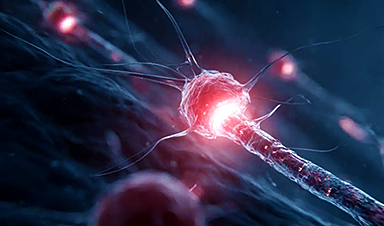Summary: A new study shows that coating neural prosthetic implants with the anti-inflammatory drug dexamethasone helps reduce the body’s immune response and scar tissue formation. This strategy enhances the long-term performance and stability of electrodes used to connect prosthetic limbs to the nervous system.
Researchers chemically modified the surface of polyimide electrodes to enable a slow release of the drug at the implant site over two months. Animal testing confirmed the method significantly reduced inflammation while preserving biocompatibility, offering a breakthrough for chronic neuroprosthetic use.
Key Facts:
- Drug Coating Innovation: Dexamethasone was covalently bound to the electrode surface for sustained local release.
- Reduced Immune Reaction: The coating lowered inflammation and scar tissue in preclinical models.
- Improved Stability: Implants maintained biocompatibility and mechanical function over critical early months.
Source: UAB
An international research team, including scientists from the Institut de Neurociències at the Universitat Autònoma de Barcelona (UAB), has developed a new solution to reduce the immune response triggered by neural prosthetics used after limb amputations or severe nerve injuries.
The approach consists of coating the electronic implants (which connect the prosthetic device to the patient’s nervous system) with a potent anti-inflammatory drug. This coating helps the body better tolerate the implant, improving its long-term performance and stability.
Neural electrode implants are commonly used in prosthetics to restore communication between the device and the nervous system.
However, their long-term effectiveness can be compromised by the body’s natural immune reaction to foreign objects, which leads to the formation of scar tissue around the implant and can impair its function.
Now, a recent study published in Advanced Healthcare Materials by researchers from the Universitat Autònoma de Barcelona, the Università di Ferrara, the University of Freiburg, and Chalmers University of Technology, conducted as part of the European collaborative project BioFINE, reports a novel method to improve the biocompatibility and chronic stability of these electrodes.
The technique involves activating and modifying the surface of polyimide (a material commonly used for implanted electrodes) using a chemical strategy that enables the covalent binding of the anti-inflammatory drug dexamethasone.
This innovation allows the drug to be released at the implant site slowly over at least two months, a critical period when the immune system typically mounts its strongest response.
Biological tests showed that this approach reduces inflammation-related signals in immune cells, while maintaining the material’s biocompatibility and mechanical integrity.
Animal testing further confirmed that the dexamethasone-releasing implants significantly reduce immune reactions and scar tissue formation around the device.
These findings suggest that the slow and localized release of dexamethasone from the implant surface could extend the functional lifespan of neural prostheses, offering a promising step forward in addressing the long-term challenges of implantable neurotechnology.
“This is a main step that has to be complemented by the demonstration in vivo that this coating improves the functional performance of chronically implanted electrodes in the peripheral nerves, for stimulating and recording nerve signals”, says Dr. Xavier Navarro, principal investigator of the UAB team in the BioFINE project.
News
Magnetic nanoparticles that successfully navigate complex blood vessels may be ready for clinical trials
Every year, 12 million people worldwide suffer a stroke; many die or are permanently impaired. Currently, drugs are administered to dissolve the thrombus that blocks the blood vessel. These drugs spread throughout the entire [...]
Reviving Exhausted T Cells Sparks Powerful Cancer Tumor Elimination
Scientists have discovered how tumors secretly drain the energy from T cells—the immune system’s main cancer fighters—and how blocking that process can bring them back to life. The team found that cancer cells use [...]
Very low LDL-cholesterol correlates to fewer heart problems after stroke
Brigham and Women's Hospital's TIMI Study Group reports that in patients with prior ischemic stroke, very low achieved LDL-cholesterol correlated with fewer major adverse cardiovascular events and fewer recurrent strokes, without an apparent increase [...]
“Great Unified Microscope” Reveals Hidden Micro and Nano Worlds Inside Living Cells
University of Tokyo researchers have created a powerful new microscope that captures both forward- and back-scattered light at once, letting scientists see everything from large cell structures to tiny nanoscale particles in a single shot. Researchers [...]
Breakthrough Alzheimer’s Drug Has a Hidden Problem
Researchers in Japan found that although the Alzheimer’s drug lecanemab successfully removes amyloid plaques from the brain, it does not restore the brain’s waste-clearing system within the first few months of treatment. The study suggests that [...]
Concerning New Research Reveals Colon Cancer Is Skyrocketing in Adults Under 50
Colorectal cancer is striking younger adults at alarming rates, driven by lifestyle and genetic factors. Colorectal cancer (CRC) develops when abnormal cells grow uncontrollably in the colon or rectum, forming tumors that can eventually [...]
Scientists Discover a Natural, Non-Addictive Way To Block Pain That Could Replace Opioids
Scientists have discovered that the body can naturally dull pain through its own localized “benzodiazepine-like” peptides. A groundbreaking study led by a University of Leeds scientist has unveiled new insights into how the body manages pain, [...]
GLP-1 Drugs Like Ozempic Work, but New Research Reveals a Major Catch
Three new Cochrane reviews find evidence that GLP-1 drugs lead to clinically meaningful weight loss, though industry-funded studies raise concerns. Three new reviews from Cochrane have found that GLP-1 medications can lead to significant [...]
How a Palm-Sized Laser Could Change Medicine and Manufacturing
Researchers have developed an innovative and versatile system designed for a new generation of short-pulse lasers. Lasers that produce extremely short bursts of light are known for their remarkable precision, making them indispensable tools [...]
New nanoparticles stimulate the immune system to attack ovarian tumors
Cancer immunotherapy, which uses drugs that stimulate the body’s immune cells to attack tumors, is a promising approach to treating many types of cancer. However, it doesn’t work well for some tumors, including ovarian [...]
New Drug Kills Cancer 20,000x More Effectively With No Detectable Side Effects
By restructuring a common chemotherapy drug, scientists increased its potency by 20,000 times. In a significant step forward for cancer therapy, researchers at Northwestern University have redesigned the molecular structure of a well-known chemotherapy drug, greatly [...]
Lipid nanoparticles discovered that can deliver mRNA directly into heart muscle cells
Cardiovascular disease continues to be the leading cause of death worldwide. But advances in heart-failure therapeutics have stalled, largely due to the difficulty of delivering treatments at the cellular level. Now, a UC Berkeley-led [...]
The basic mechanisms of visual attention emerged over 500 million years ago, study suggests
The brain does not need its sophisticated cortex to interpret the visual world. A new study published in PLOS Biology demonstrates that a much older structure, the superior colliculus, contains the necessary circuitry to perform the [...]
AI Is Overheating. This New Technology Could Be the Fix
Engineers have developed a passive evaporative cooling membrane that dramatically improves heat removal for electronics and data centers Engineers at the University of California San Diego have created an innovative cooling system designed to greatly enhance [...]
New nanomedicine wipes out leukemia in animal study
In a promising advance for cancer treatment, Northwestern University scientists have re-engineered the molecular structure of a common chemotherapy drug, making it dramatically more soluble and effective and less toxic. In the new study, [...]
Mystery Solved: Scientists Find Cause for Unexplained, Deadly Diseases
A study reveals that a protein called RPA is essential for maintaining chromosome stability by stimulating telomerase. New findings from the University of Wisconsin-Madison suggest that problems with a key protein that helps preserve chromosome stability [...]





















